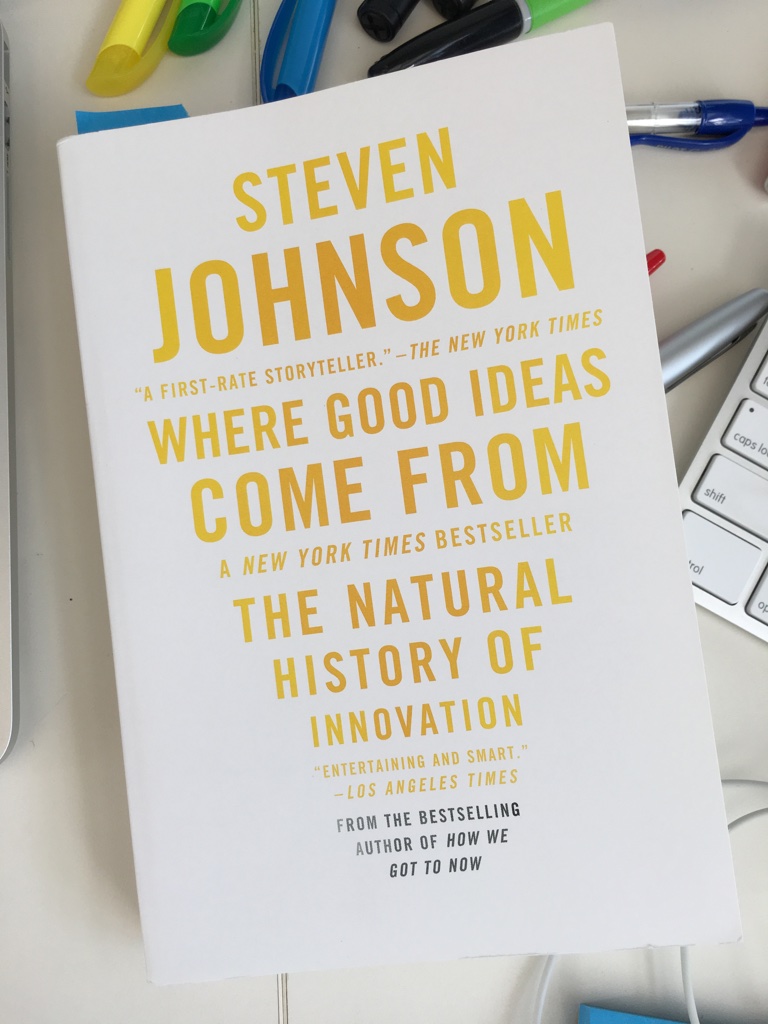Where Good Ideas Come From, by Steven Johnson
Most people would probably like to be able to regularly pump out good ideas. But, it’s hard to do this if you don’t understand how ideas pop up. Is it random? Are some people just more creative than others? What kind of environments help foster this creative output?
These are intriguing questions, and Steven Johnson investigates the origins of good ideas in his book Where Good Ideas Come From. His search spans history, and he describes how certain ideas came about and what factors contributed to generating these ideas. He tries to categorize these factors based on shared characteristics, which become the basis for the book’s chapters.
While thoughtful in his approach, parts of the book feel repetitive at times. As you read the chapters, you start to realize how many of the ideas he highlights as examples for specific chapters really involve multiple contributions and could have easily been used in different chapters. For example, in a chapter about Platforms, Johnson describes the development of GPS and how it grew from a research lab at the Applied Physics Laboratory (APL) at Johns Hopkins. He labels the APL a “platform” since it allowed the ideas and hunches of researchers to be connected with those of others. The environment of the APL allowed other ideas to build and snowball, leading to further testing and refinement. However, the APL could have easily been in the Liquid Networks chapter, with scientists and engineers moving around in close enough proximity to promote the rapid flow of ideas. This ease of transduction allows for new collaborations to spring up.
While Johnson’s method of categorization gives a sense of repetition, if you step back and think about it from a different angle, it’s actually quite thought-provoking, as it really highlights the complex origins of ideas and the multiple factors that go into the process of idea generation. The multiple facets and contributions that go into idea generation is complicated and overlapping. This makes it challenging to easily group these factors into orderly and distinct buckets.
Instead of looking at the separate components of idea generation, when you look at the overlap of his ideas and try to identify the underlying thread of commonality, you see that the theses of each chapter are really based on a single fundamental concept: the concept of collision.
Generating an idea – good, bad, or whatever – requires collisions. These collisions could be within your own head, like when you’re fitting together some pieces of a conceptual puzzle as you work to form and shape an idea. Johnson highlighted the value of dreaming and how it provides a space where information can bounce around and form crazy combinations. Allowing these collisions to occur increases your opportunity to generate valuable connections. This can help the mind sort the morass of information in your mind and link key information.
Alternatively, these collisions could happen between people: taking someone’s idea to the next logical extension, ricocheting ideas between people in a dense environment for efficient idea transfer, or applying others’ work toward novel uses. Johnson mentions the productivity and idea generation that arise from densely populated cities, universities, and other places were collisions can frequently occur.
As you can see, collisions are key. Much like how a fusion reaction requires the collision of particles to create new elements, you want to foster intellectual environments that allow for and encourage ideas to collide. Steve Jobs famously helped design the Pixar building to encourage these types of interactions.
Where Good Ideas Come From was a partial inspiration for this blog. I wanted a place to capture my ideas and densify them, with the hope that I may see new connections.
So, in the spirit of Johnson’s book, we should strive to let our hunches, ideas, and notions bump into each other. Let them be messy, mistake-ridden, and tangled. Let them fuse, amalgamate, and build upon one another. That’s where good ideas come from.
This was the July 2019 selection for the Dan & Andy Book Club, a two-person book discussion “club” that was formed mostly as a way to keep two former college roommates in semi-regular contact and encourage each other to read more. Additional book selections may be discussed in future posts.
